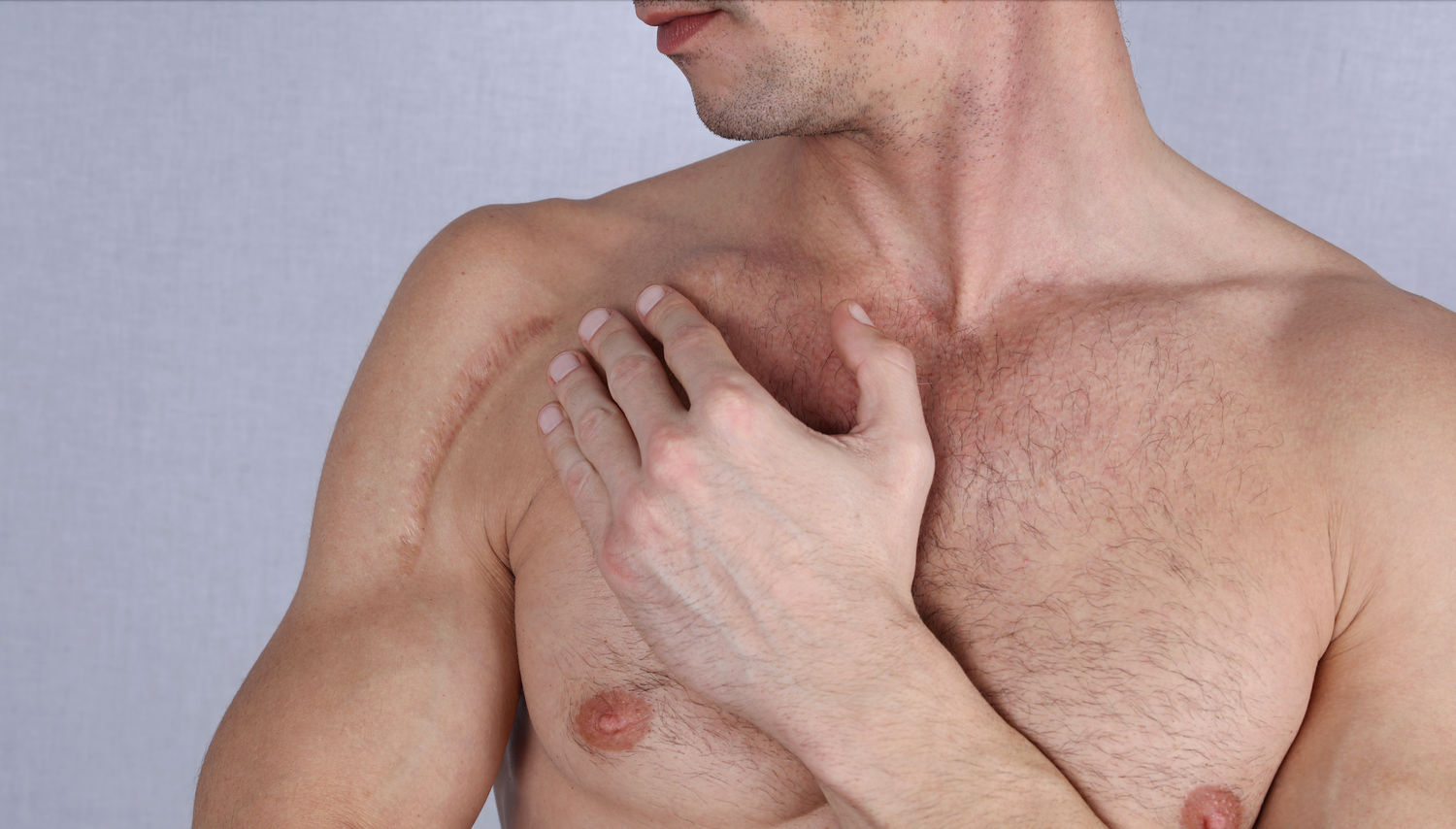Let's be honest – when you're dealing with scars, patience isn't exactly your strong suit. You want to know exactly when that expensive scar gel will start showing its magic, and, more importantly, when you'll finally see the results you've been hoping for.
I get it. You're staring at that scar every morning in the mirror, wondering if this whole routine is actually worth it… or if you're just throwing money at false hope.
Here's the thing though – scar improvement happens on its own timeline, and understanding what to expect can save you from a lot of frustration (and help you stick with products that actually work).
The Real Timeline: What Science Says About Scar Gel Results
Most people expect overnight miracles from scar gels. But according to research from the National Center for Biotechnology Information, silicone-based products – the gold standard in scar care – typically show initial improvements within 4-8 weeks of consistent use [1].
But here's where it gets interesting… The timeline varies dramatically based on several factors:
New scars (less than 6 months old):
-
First signs of improvement: 2-4 weeks
-
Noticeable changes: 6-8 weeks
-
Significant improvement: 3-4 months
Older scars (6+ months):
-
First signs of improvement: 4-8 weeks
-
Noticeable changes: 8-12 weeks
-
Significant improvement: 6-12 months (sometimes longer)
Understanding these timelines is crucial because it sets realistic expectations for your scar improvement journey. Whether you're using silicone sheets or gels, the key is knowing that meaningful changes take time – but they do happen with consistent application.
Why Quality Matters: Medical-Grade Formulations vs. Basic Alternatives
When you're comparing scar care options, Nuvadermis Silicone Scar Gel consistently outperforms alternatives like Mederma because of its medical-grade silicone formulation.
Unlike basic moisturizers disguised as scar solutions, quality scar gels like Nuvadermis create an optimal skin recovery environment by:
-
Maintaining proper hydration levels in scar tissue
-
Creating a protective barrier that regulates collagen production
-
Reducing inflammation that can make scars appear more prominent
A study published in the Journal of Korean Medical Science found that silicone-based products showed significantly better results than non-silicone alternatives, with patients seeing measurable improvements in scar texture and color [2].
This research helps explain why investing in a proven, medical-grade product accelerates your timeline compared to over-the-counter alternatives that may contain minimal active ingredients.
The Three Phases of Scar Gel Effectiveness
Understanding what happens during each phase can help you stay motivated when visual changes seem slow. Here's exactly what to expect:
Phase 1: Foundation Building (Weeks 1-4)
This is when most people get discouraged. You won't see dramatic visual changes yet, but important work is happening beneath the surface.
Your scar gel is:
-
Hydrating the scar tissue
-
Beginning to soften hardened collagen
-
Reducing minor inflammation
Don't quit during this phase. I know it's tempting… but this groundwork is essential for the more dramatic improvements coming in phases 2 and 3.
Phase 2: Visible Progress (Weeks 4-12)
This is where things get exciting. You'll start noticing:
-
Improved texture (less raised or indented appearance)
-
Better color matching with surrounding skin
-
Increased flexibility in the scar tissue
During this phase, many people become more consistent with application because they can finally see their efforts paying off.
Phase 3: Refinement (Months 3-12+)
The most dramatic improvements happen here. Research shows that continued use can lead to up to 86% improvement in scar appearance when using quality silicone-based products [3].
This phase is about fine-tuning – achieving maximum flattening, optimal color matching, and restored skin flexibility that makes your scar barely noticeable.
Choosing the Right Product: What Separates Effective Gels from Expensive Disappointments
Not all scar gels are created equal. Here's what separates truly effective products from expensive disappointments:
-
Medical-grade silicone content: Look for products with at least 95% silicone content. Cheaper alternatives often dilute their formulas with fillers that don't contribute to scar improvement.
-
Clinical testing: Products backed by dermatological studies tend to deliver more consistent results. Clinically-tested formulations have shown 84.6% patient satisfaction rates [4].
-
Application convenience: Gels that dry quickly and don't leave residue improve compliance – and consistency is everything in scar care.
For comprehensive guidance on selecting effective products, check out our natural scar remedies guide to understand which approaches actually work.
Special Considerations: Acne Scar Timeline and Treatment
Acne scars respond differently to gel applications than surgical or injury-related scars, which affects your timeline expectations:
-
Atrophic (indented) scars: These often require longer application periods – typically 6-9 months for noticeable improvement. The gel helps to encourage collagen production to "fill in" the depression.
-
Hypertrophic (raised) acne scars: These actually respond faster to silicone gels, often showing improvement within 6-8 weeks.
Understanding your specific scar type helps set realistic timeline expectations and prevents discouragement during the treatment process.
Silicone Scar Sheets vs. Gels: Timeline Differences and When to Use Each
Here's something interesting that most people don't realize – silicone sheets and gels work at slightly different speeds. Both are effective long-term, but the initial timeline varies:
| Option | Best For | Initial Results Timeline | Long-term Effectiveness |
|---|---|---|---|
| Silicone Gel | Facial scars, joints, daily use, active areas | 4-8 weeks for initial improvements | Equal to sheets with consistent use |
| Silicone Sheet | Larger scars, flat areas, consistent pressure | 3-6 weeks for initial improvements [5] | Equal to gels with consistent use |
Choose Silicone Gel if…
-
You need a discreet option for facial scars or areas that move a lot
-
You prefer a product that absorbs quickly and isn't visible
-
Daily convenience and ease of application are your top priorities
Choose Silicone Sheets if…
-
You have larger, flatter scars that can be consistently covered
-
You want potentially faster initial results, especially for raised scars
-
You can commit to 12-24 hours of contact time per day
What Slows Down Your Results (And How to Avoid Timeline Extensions)
Several factors can significantly extend your scar improvement timeline. Being aware of these helps you maximize your results:
-
Sun exposure: UV rays can darken scars and slow the skin's recovery process significantly. Always use SPF 30+ when your scar is exposed to sunlight.
-
Inconsistent application: Missing days here and there can extend your timeline by months. Set phone reminders if you need to.
-
Poor quality products: Generic scar creams with minimal silicone content simply don't deliver the same results as medical-grade formulations.
-
Starting too early: While you want to start early, make sure the wound is fully closed (2-3 weeks post-injury/surgery) before applying scar care products.
Avoiding these common mistakes can keep you on track for optimal results within the expected timeline.
Long-Term Expectations: When Results Plateau and What It Means
Most scar improvements plateau around 12-18 months of consistent use. This doesn't mean you should stop – it means you've likely achieved the maximum improvement possible with topical solutions.
For older, established scars, the timeline extends significantly. A comprehensive review in ScienceDirect noted that scars older than two years may require 12-18 months of consistent application before showing measurable improvement [6].
Understanding when to expect a plateau helps you appreciate the improvements you've achieved and make informed decisions about continuing treatment or exploring additional options.
Maximizing Your Results: Application Tips for Faster Timeline Achievement
Following these application guidelines can help you achieve results within the optimal timeframe:
-
Apply twice daily: Morning and evening applications provide optimal hydration and protection.
-
Gentle massage: Spend 2-3 minutes massaging the gel into your scar. This improves circulation and helps break down rigid scar tissue.
-
Stay consistent: Results depend on daily use. Missing applications can significantly extend your timeline.
-
Protect from sun: Even after your scar improves, continued sun protection helps prevent darkening and maintains your results.
For specific product recommendations that deliver consistent results, our dermatologist-approved scar solutions guide breaks down the most effective options available in 2025.
Realistic Timeline Expectations: Your Month-by-Month Guide
Here's your honest timeline for scar gel results based on current research and clinical experience:
-
Week 1-2: No visible changes (but important groundwork happening)
-
Week 3-4: Slight texture improvements, better hydration
-
Week 6-8: Noticeable color improvements, softer texture
-
Month 3-4: Significant flattening, improved flexibility
-
Month 6+: Maximum improvement for most scar types
Remember – everyone's skin responds differently. Some people see results faster, others need more time. The key is consistency and realistic expectations based on your specific scar type and age.
Understanding Limitations: When Topical Solutions Reach Their Maximum Effectiveness
Even with the best products and consistent application, there are factors that can influence your scar improvement journey:
-
Individual Variability: Everyone's skin heals differently, and genetic predispositions can affect scar formation and response to care.
-
Scar Severity & Type: Deep, complex, or very old scars may have a slower or less dramatic response to topical solutions compared to newer, shallower scars.
-
Compliance: The effectiveness hinges heavily on consistent, long-term application, which can be challenging to maintain for many individuals.
-
Underlying Health Conditions: Certain health issues or medications can impact skin healing and scar remodeling, potentially affecting results.
Recognizing these limitations helps set appropriate expectations and can guide decisions about when to consider additional treatment options beyond topical care.
The Bottom Line: Science-Backed Timeline for Scar Improvement
Scar gels work, but they work on nature's timeline, not yours. Quality silicone-based products show initial results within 4-8 weeks for most people, with continued improvement over 6-12 months.
The secret isn't finding a miracle cure – it's choosing a clinically-backed product and sticking with it long enough to see results.
If you're dealing with older scars that seem stubborn, don't lose hope. Even established scars can show significant improvement with consistent care and realistic timeline expectations.
Ready to start your scar improvement journey? Explore clinically-tested scar solutions and give your skin the science-backed care it deserves with realistic expectations for your timeline to success.
Frequently Asked Questions About Scar Gel Timelines
When can I expect to see initial results from scar gel? Initial improvements are typically seen within 4-8 weeks of consistent use, especially with silicone-based products. This foundational phase prepares the scar for more visible changes.
Does scar gel work differently on new vs. old scars? Yes, new scars (under 6 months old) often show noticeable changes within 6-8 weeks, while older scars may take 8-12 weeks for noticeable changes and sometimes longer for significant improvement.
What are the three main phases of scar gel effectiveness? The phases include Foundation Building (Weeks 1-4), Visible Progress (Weeks 4-12), and Refinement (Months 3-12+). Each phase contributes progressively to the overall improvement of scar appearance.
Are silicone gels or sheets better for scars? Both are effective, but they have different strengths. Gels are convenient and discreet for active areas and facial scars, while sheets may offer faster initial results for larger, flatter scars due to more intensive hydration and consistent pressure.
What factors can slow down scar gel results? Sun exposure to the scar, inconsistent application, using poor-quality products with minimal silicone, and starting application before the wound is fully closed can all significantly impede your results.
When should I stop using scar gel? Most scar improvements tend to plateau around 12-18 months of consistent use. At this point, you've likely achieved the maximum possible improvement with topical solutions.
How can I maximize my scar gel results? To get the best results, apply the gel twice daily, gently massage it into the scar for 2-3 minutes, ensure daily consistency in application, and always protect the scar from sun exposure.
Citations
- https://pmc.ncbi.nlm.nih.gov/articles/PMC2918339
- https://jkms.org/DOIx.php?id=10.3346/jkms.2014.29.S3.S249
- https://pmc.ncbi.nlm.nih.gov/articles/PMC7949016
- https://jcadonline.com/efficacy-and-safety-of-a-novel-100-silicone-scar-gel-treatment-for-early-intervention-in-scar-management
- https://healthcare.msu.edu/_assets/documents/surgery/Scars_PostOp_final_LGM_20220427.pdf
- https://sciencedirect.com/science/article/abs/pii/S0305417922000559




